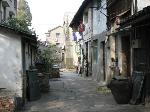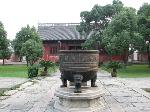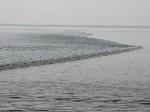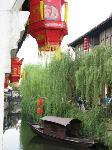- Getting around Lijiang. Dont stay in the Old Towns more than 2 days, there is nothing to do. KRISS Oct 9, 2013 05:46
- 2013 Beijing Temple Fair BENNYLAU Feb 26, 2013 03:29
- Malaysian traveling from KUL - LAX vis Shanghai PVG ZATI_DY Jan 3, 2013 20:15
Yanguan: The Ancient Town & Tidal Bore
- Views: 56835
- |Vote: 1 0
- |Add to Favorites
- |Recommend to Friends
A Midweek Moon-Inspired Mini-Adventure
The October, National Day holiday this year coincided with Mid Autumn Day (中秋节), to produce one point in the so-called “Golden Triangle” of national holidays in China. Whilst some may predict the demise of traditional Chinese festivals, Mid Autumn Day at least in my experience, continues to enjoy significance in the consciousness of China’s youth, despite a good half of my students openly admitting they dislike that sickly-sweet, pastry-covered staple: the Moon Cake (月饼).
Given the choice, I’d never take my holidays at this time but not denying the many perks of teaching, choosing when to take your holidays is not one of them. Imagine the 10,000 students from my University taking to public transport, multiplied across the country and added to the working population and you begin to see why. Needless to say however, whilst munching on Moon Cakes (perfectly suited to my sweet palate) and with no chance of a rendezvous with my own family, I did the next best thing and planned my own midweek moon-inspired mini-adventure to the town of Yanguan (盐官).
Yanguan: Home To The World’s Largest Tidal Bore
The journey from my home to Yanguan, via Haining (海宁) and bypassing Hangzhou (杭州), would take over 4 hours. I had plenty of time on the pleasantly un-crowded minibus to wonder about Yanguan. I’d come across the only vague and contradictory information about it on the internet. This is typical of my experiences of trying to find information about Chinese tourist destinations in English and whilst frustrating, also provides an element of surprise and mystery that appeals to me.
Yanguan, therefore, was my destination because of its apparently single claim to tourist fame: it is home to the World’s Largest Tidal Bore.
Here in Zhejiang, water from Hangzhou Bay (杭州湾) travels up the Qiantang River (钱塘江). The narrowing of the river, from 100km at its mouth to only a few kilometres inland, and a gently rising riverbed, means that the water is constricted and a large wave is created. This is the tidal bore. Qiantang’s Tidal Bore (钱塘江潮), also known as the Black or Silver “Dragon”, holds the world record reaching a height of 8.9m and a speed of 40km an hour.
Of course, actually seeing the bore depends largely on luck: a combination of moon and high tide in reality, which occurs at certain times of the month throughout the year. The Mid Autumn Festival, home to the fullest moon, is traditionally associated with viewing this phenomenon and whilst I wouldn’t be there on that exact day, I was just 2 days early and kept my fingers crossed.
My First Impressions Of Yanguan
Arriving in Yanguan was an anticlimax. The bus pulled into a jumble of disused garages that served as the bus station. Fortunately the “station” is across the road from Guanchao Shengdi Park (观潮胜地公园) where I was hoping to view the bore and so I quickly made enquiries and found that I would have to wait until the next morning. I’d planned on staying the night anyway and set off in search of accommodation.
Yanguan is very small and probably only just qualifies to be called a town. It suffers from neither of the twin uglinesses of your average Chinese town, excess traffic and high-rises, a fact I attribute to it being relatively poor and something I can’t deny that made it a very attractive place to be.
Renmin Road (人民路) is the main street and I happily wandered its length. It runs north from the park. The street is narrow, barely wider than a single car, and each side was lined with small shops and restaurants. Along the pavements sellers expertly peeled and piled their sugar cane. My passing caused a wave of friendly curiosity and I stopped often to test out my Chinese with the slightly shy and ever-so-charming locals. Occasionally, convoys of youngsters on bright scooters filed by with bright smiles and waves.
Parallel to Renmin Road is a narrow street where I found a hotel for the night. I entered the courtyard and a group of elderly locals sat engrossed in a game of Mahjong (麻将). Washing hung from the windows in colourful arms and legs. My room was grotty with a leaky toilet but it was on the third floor and a huge Magnolia Grandiflora held its burnished green and bronze leaves outside the window. I felt I was in forest and, in the peace of that narrow alley, the sound of sparrows clattering in and out of the thick leaves would wake me the next morning.
Ancient Yanguan: Stepping Back In Time
Almost directly opposite my hotel, running perpendicular to Renmin Road is an extraordinary part of the ancient town of Yanguan. I felt as though I had stepped into Lijiang, as nowhere else have I encountered the same intricacies of street edged canals. The brimming greens of the willows weeping and the jaunty lanterns hanging from the wooden buildings were a winning combination that even the crowd couldn’t spoil.
Fortune Making Bridge (东兴桥), at the entrance to the ancient town, is a must for anyone hoping to make it rich. Legend has it that the Emperor Qianlong, on one of his four visits to Yanguan, lost a jade plate here. The local who found the plate eventually became a wealthy merchant and stepping across the bridge is believed to bring the blessing of the imperial spirit and good fortune.
There are many places to visit within the ancient town, including temples, a teahouse and a craft museum. Many of the original buildings are now home to souvenir sellers, upmarket restaurants and craftsmen and women, but still this stranded piece of ancient China manages to retain an air of authenticity and quiet industry.
Proclaiming Virtue Gate (宣德门) marks the end of the ancient town and was originally built in 617AD although it has since been destroyed and rebuilt in successive dynasties. Emperor Qianlong passed through this gate on each of his six inspections of the regions south of the Changjiang River.
Ancient Yanguan: Lights, Camera, Action
Similarly to the formation of the tidal bore, the narrow streets of ancient Yanguan had a profound effect on the amount of people and at one point I came across a wall of bodies beyond which it was impossible to get. They were all watching something and there was an air of excitement. I wedged myself in with the masses on a narrow bridge overlooking the canal and found myself with an excellent view of the proceedings.
A large section of the town had been commandeered by a film crew and a host of actors, actresses, lights, horses, carts and other assorted props were being assembled. It was fascinating (and not a little dangerous) to watch the street being populated by an ancient cast of characters and lives. From time to time huge props would be hoisted across the bridge I was standing on and the crowd had to squeeze into spaces that didn’t exist. Great round extension cables were wheeled around and the poor runners were dashing backwards and forwards with sweat glistening on their faces. A young woman with a loud haler and a clip-board barked efficient orders to innumerable cast and crew on both sides of the canal.
By the reaction of the crowd I figured at least some of the actors and actresses were famous. I later found out that the programme being filmed is called LuDingJi (鹿鼎记). I didn’t hear the call of “Lights, Camera, Action” or its equivalent in Chinese, but the crowd suddenly silenced, the huge spotlight (even on this bright day!) ignited and the cameras rolled. A boat carrying richly dressed men and women appeared and the extras on the streets began to wave and cheer as though welcoming someone home…
I watched the same scene being shot, and re-shot, perhaps four times over the space of an hour before reflecting that filming must sometimes be rather tedious. I left.
The Temple Of The Sea God
Located in the south-eastern corner of Yanguan is the Temple of the Sea God (海神庙). The original temple was finished in 1731 after 20 months of construction and covered an area of almost 3 hectares. It has twice been almost completely destroyed and the temple that exists now enjoys both government protection and funding. The temple is believed to have been built for the specific purpose of worshipping the God of the Qiantang River.
The temple and its grounds are a pleasant place to spend some time. Visitors were few and I found myself alone in the grounds surrounded by the greens of grass and bamboo, the pale wood and stone and the outer red wall. The complex is full of carvings of dragons in stone or wood and wooden lanterns hang from the temples richly painted ceilings. A great statue of the Sea God himself resides in the main temple, behind him is painted the river and a dragon, their bodies combined in great waves.
Yanguan By Night: A TV Star & A Duck’s Head
One of my abiding memories of China is the hospitality of the people I meet and it was whilst looking for a place to dine that I struck up conversation with a group of locals who immediately invited me to dinner with them. I gratefully accepted their company and warm curiosity and they took me to one of the smart restaurants in the ancient town.
The ambience was magical and romantic. The canal, stars overhead, was lit by red lanterns and the warm glow of the restaurants. We took a table near the window looking out over the canal and my new companions, after confirming that I was “used to” eating Chinese food, ordered large.
A delicious fish dish cooked in foil, glutinous sweet rice, spicy tofu, pork, soup, vegetables and, a plate of ducks’ heads. My reticence to eat a duck’s head was met with amused glances from the locals who all began extolling their virtue, particularly that if I ate a duck’s brain, that my brain would somehow benefit. I wasn’t convinced. However, it became clear that the heads were symbolic for this meal and as everyone accepted theirs, I could only oblige and follow.
Towards the end of the meal, an actor walked into the restaurant and past our table, causing a great commotion. He was dressed in his ancient clothes and his hair was swept back from his face and hung down his back in a thick plait. When he exited a few minutes later (I’m pretty sure he just came in to use the toilet!) one of my companions ran over to him to get his autograph and tell him how much he liked him. The actor looked half embarrassed and half annoyed, ignored my companion and disappeared out into the night.
Wave Spotting: Qiantang’s Tidal Bore
The next morning, heady with anticipation, it was at least an hour before the wave was expected that I arrived at the park. The word on the street was that it was due at around 11am. The park is long and thin stretching down the side of the Qiantang River and dominated by a tall pagoda. The park is worth an hour or two of time to stroll through, although for me it was the river itself which drew my attention.
Whatever I was expecting of the River; blue water perhaps; or the picturesque bank opposite; the reality proved in stark contrast. The River was a murky grey and stretched into the distance as though it were the ocean itself. The overcast skies didn’t help, but the dark bank opposite seemed nothing more than a line of cloud. The scene was a lesson in the myriad shades of the colour grey.
I was caught up in the gloomy nothingness of it, watching the beauty in this apathetic edge. Like many others I climbed over the barrier and sat on top of the wall, and waited…
The Tidal Bore: Less A Dragon, More A Mouse
It began as a dark grey line, noticeable only in that it was higher than the flat river but hardly more visible than the far shore. It crept closer and offered the weird feeling that the river was somehow flowing backwards. Water advancing on water is a strange sight. As it neared, the low growl of a wave forming but never breaking came with it and the wave itself became visible.
Though not surprised I couldn’t help feeling a little disappointed. Perhaps the wave was as much as half a meter in places, but it was less a dragon and more a mouse.
The wonder of it stirred me though, the oddity of what I was seeing. Water rushing on top of water, as though the river was a metal surface to be swamped by a single wide wave. Even at this size I felt a formidable power within the water, an inevitability to its insistent progression. It became easier for me to understand the number of victims claimed by this river over the years.
***
I dispersed, along with the crowd, feeling delighted with my trip to Yanguan. A town that introduced me to far more than a big wave: to ancient China, to celebrity and to the complicated delicacy that is a duck’s head. Whether dragon or mouse, the tidal bore has swept along this river for centuries, Yanguan has similarly endured – and I like that.
Information (October 2006)
Yanguan is a small town located 38km north east of Hangzhou in Zhejiang Province.
Getting There
From: Lin’an (临安) to Haining North Station (海宁北站)
By: Minibus
Cost: 36RMB
Time: 06.40 – 09.30 (3 hours)
From: Haining to Yanguan (盐官)
By: Bus
Cost: 6RMB
Time: 1 hour (buses leave regularly from outside the North Bus Station)
Getting Back
From: Haining to Lin’an
By: Minibus
Cost: 34RMB
Time: 1.35pm – 5pm
Attractions Information
1. English: Qiantang Tidal Bore
Chinese: 钱塘江潮
Pinyin: qian2 tang2 jiang1 chao2
Contradictory information exists as when is the best time to see it.
High tides are usually found around the beginning and the end of each LUNAR month. Mid Autumn Day is when the festival is held.
Best viewed from The Park.
Chinese: 观潮胜地公园
Pinyin: guan1 chao2 sheng4 di4 gong1 yuan2
Entrance Fee: 20RMB
Check at the park for times of viewing the tide or ask the locals.
2. English: Temple of the Sea God
Chinese: 海神庙
Pinyin: hai3 shen2 miao4
Entrance Fee: 10RMB
3. English: The Former Residence of Wang Guowei
Chinese: 王国维故居
Pinyin: wang2 guo2 wei2 gu4 ju1
Entrance Fee: 10RMB
Wang GuoWei 1877-1927: Chinese Ci Poet and scholar
The house is a small wooden building centred around a courtyard. Many of his writings are contained within it along with reconstructions of his study etc. Naturally all the signage is in Chinese. I wouldn’t advise visiting unless you have a particular interest in him and your Chinese reading level is good!
4. There are other attractions located in and around the ancient town of Yanguan. Entrance fees range from 10-20RMB. The ancient town itself is free to wander around and well worth your time.
Accommodation
I paid 90RMB for a night. The room was grubby. Double bed, TV, air-con and bathroom with leaky toilet and a rusty shower. Quiet though.











 Copyright © 1998-2024 All rights reserved.
Copyright © 1998-2024 All rights reserved.